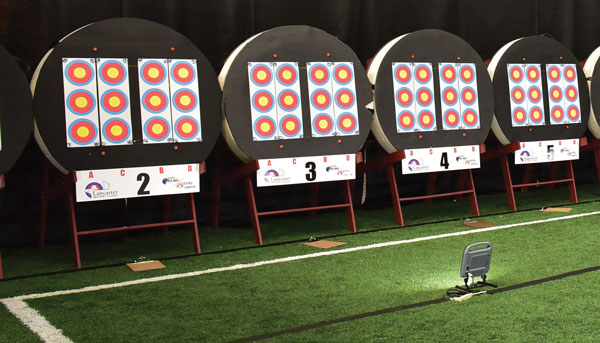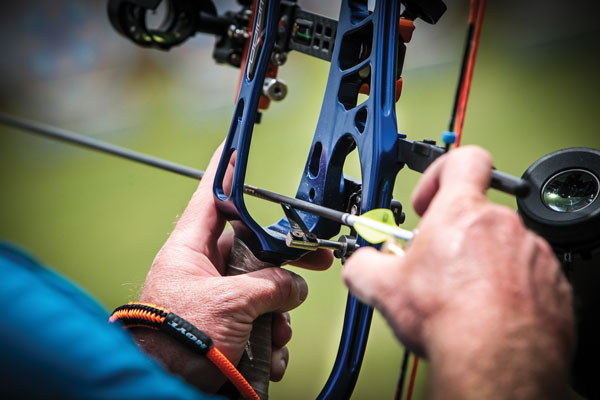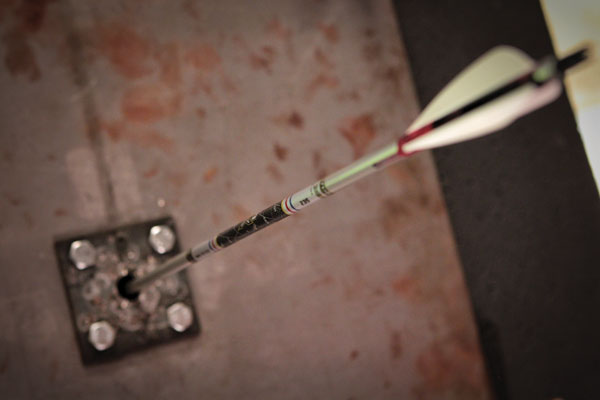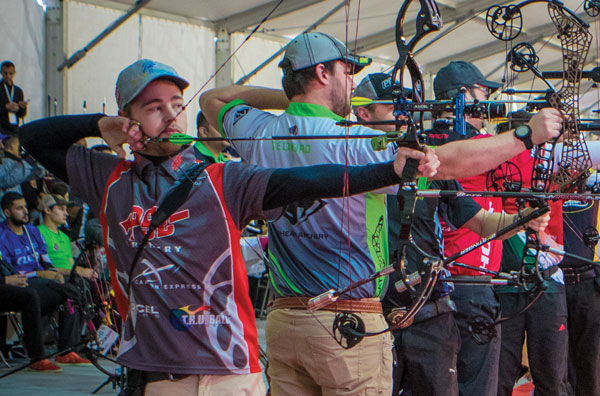Duncan Busby reveals some of the most common questions he’s asked as a coach – and the answers

Don’t be put off by the technicality of compound archery
Compound archery can be a rather technical discipline; whether you want to learn how to set up your bow or tune your arrows there is always a lot of information to learn. As a both a coach and competitor I’ve seen or experienced nearly every problem in this sport and over the years I’ve been asked how to solve them all, so as an aid to every compound archer in training I’ve compiled a collection of some of the questions I’m most frequently asked…
1. How do I choose the correct arrow spine for me?
Before buying a set of arrows you should spend time researching your chosen arrow brand; all manufacturers produce arrow charts which allow you to select the correct arrow spine depending on your draw length, poundage and bow specs. The arrow charts will usually get you very close to a perfect spine, but they are not infallible, and sometimes a bit of experience is needed to select the best match to your bow so don’t be afraid to ask for help from archers in the know.
If informed recommendations from others aren’t available, spine selection software like ‘Archers Advantage’ can be just as invaluable – only make sure that you enter the information about your bow setup carefully or you will get inaccurate recommendations.
Once you have chosen your arrows, you need to make sure that they tune to your bow; this is best done with a paper test as it’s usually the clearest diagnosis of any issues. Large, unfixable tears can be a sign that your arrows are too stiff or too weak, which can be confirmed by adjusting your bow’s poundage. Simply wind your poundage up or down until your arrows start to produce a bullet hole.
You should also observe your group patterns. As a general rule you will find arrows that are too weak will produce a tight central group but any bad shots will sit far outside of it, whereas stiff arrows won’t punish you as much for bad shots but they will produce more open groups. For this reason I would always advise going slightly stiffer when cutting your arrows; a stiffer spine will be easier to tune to your bow and will be more forgiving when you make a bad shot – just make sure your arrows aren’t too stiff or you may find it difficult to shoot tight groups, and remember you can’t un-cut an arrow!

If you are using a blades style arrow rest, you might find the blades keep snapping
2. How do you find the true centre shot on a compound bow?
Finding the true centre shot of your bow is an important part of tuning; it will not only help you to achieve straighter arrow flight and better power transfer to the arrow, but it will also eliminate the need for you to adjust your sight’s windage as you move up and down distances.
To find your bow’s centre shot you should roughly centre your arrow in the bow; to do this, nock your arrow on the string and sit it on the launcher; then look down the back of the bow and line up the string with the centre of the bow. Now line your arrow up with the string. This can be a little tricky for some archers but it doesn’t have to be perfect, just close enough at this point. If you’re finding it difficult there are several tools available that can help you to find the centre shot more easily, so it may be worth looking into one of these.
Some manufacturers provide a centre shot measurement for their bows which is measured from the rest mount hole to the centre of the arrow, and if you are struggling to line things up by eye this measurement can be useful. If you can’t find a specific measurement from your manufacturer, setting it to around ¾ of an inch should work on most bows.
Now in order to find the exact centre shot for your setup you will need to do a French tune; this is a kind of abbreviated walk back tune specifically designed for compounds. It is important to do this in calm weather, and you should make sure that your sight’s first and second axes are properly set or you may find the test can give you inaccurate results.
Start by setting your sight to your 50-metre sightmark and, standing around two or three metres from the target, shoot an arrow aimed squarely at the middle. Adjust your sight’s windage until you are hitting exactly on the cross – don’t worry if it’s a little high or low, it’s only the arrow’s left and right position that’s important here. Once your arrow is hitting in the dead centre leave it in the target and walk back to 50 metres. Without moving your sight, shoot the rest of your arrows also aimed at the middle of the target. Your close range arrow and the arrows shot from 50 meters should be in perfect alignment; again, don’t worry if they aren’t the same height, they just need to be in a straight line up the target. If the arrows shot at 50m are to the left or right of the close-range arrow, you will need to move your arrow rest; to correct left results move your arrow rest to the right and to adjust arrows hitting to the right move your rest to the left. Once you’ve made your adjustments, go back to two or three metres, re-set your sight’s windage, and do the test again. Repeat until your arrows are perfectly lined up.

Before buying arrows, you need to research your chosen arrow brand
3. I am using a blade style arrow rest but find that the blades are constantly snapping where they connect with the retaining arm. Is this a common problem, and how do you fix it?
This is a fairly common problem and it is a bit of a pain; the blade is designed to flex on release to allow the arrow to clear the bow with minimum effect on its flight. If you’re snapping a lot of blades it usually means you are putting too much stress on them, but breakages can happen for a number of reasons:
Your arrow could be too heavy for the blade. A .10 blade is more than sufficient for most arrows, even some indoor ones, but you may need to use a .12 blade for very heavy arrows. Check the recommended arrow weight for your specific blade to ensure you aren’t overloading it.
You could be using the wrong width blade; blades come in various different widths to accommodate any diameter of arrow, and using a blade designed for fatter arrows than you are using will cause a lot of contact between the vanes and the prongs. This can damage the blade and cause it to break over time, so make sure you get the correct sized blade for your arrows.
The angle of the blade may be set incorrectly; it should be at a 35 to 40 degree angle so that the arrow is being supported properly by the blade. If your blade angle is set too shallow your arrow may be making too much contact, which will cause the blade to weaken and break. Conversely, if your blade angle is too steep you may get fletch contact with the prongs, again causing the blade to flex more than it’s designed to.
Your blade may have been damaged; many bow cases have net dividers inside to keep all your equipment separate, but it’s very easy for your blade to become snagged on it when packing or un-packing your kit. Even if your case seems smooth inside there are still things your blade can catch on, so it’s important to take care when putting your bow into its case. I’ve found that a cardboard sleeve or target face folded around the bow can help to reduce the chance of any damage to your blade.
You may have a number of tuning issues with your bow which can cause excessive contact with your blade; a badly positioned nock point can create contact; so make sure that you begin tuning with a flat nock point, at 90 degrees to the string, before checking your arrow flight with a paper test. Badly timed cams can also put pressure on your blade due to poor nock travel, so it’s a good idea to check that they’re in time. Finally, make sure that your arrows are the correct spine for your bow, as shooting too weak a spine can create a lot of arrow flex and put more pressure on the blade.
4. I am relatively new to archery and I’d like to enter my first competition, but I’m worried I’ll be out of my depth. Can you advise me of where I should start?
Entering your first tournament can be a daunting process; do you attend a local or a national tournament? Which round and distances should you shoot? For your first time out I’d recommend that you choose a familiar round, with distances you are comfortable shooting. Practice at your club first with some of the more experienced archers so you know the basics and are comfortable with the process. Finding a local tournament with other people from your club may make things easier since familiar company can be reassuring; however, once you are there you will get to know other archers very quickly. Read up on the round you will be shooting and familiarise yourself with some of the more important rules – these can differ between rounds so make sure you find out what they are. If you are a bit confused when you arrive ask someone there; archers are a friendly bunch and will be more than happy to help you along. Tournament organisers and judges are a good source of information too, so don’t be afraid to ask. Tournaments are a fun way to take your sport to the next level, start small and who knows, in a few seasons you may find yourself shooting at the World Championships.

Entering your first tournament can be daunting…
5. I made a commitment to shoot with a back tension release aid; it seemed to be going really well and my shot settled in after only a few weeks, but now I find that I can’t cope if there’s even a breath of wind. I get blown around a lot, and I can’t get the shot to break. What am I doing wrong?
This is a fairly common problem that most back tension shooters will experience at some point; put basically you’re hanging up on your shot because your sight is moving around the target. This ‘mental block’ happens because your mind is telling you that it isn’t possible to hit the middle of the target while your sight is moving and it causes you to tense up.
There are a few steps you can take to overcome this problem but they will require a bit of practice and trust in your form; firstly, I’d advise doing some blank boss shooting in order to get the feel and flow of your shot back without the added complication of aiming. This will help to build your confidence and your muscle memory.
Secondly, I’d advise you to work on your mental discipline; when you find yourself shooting in the wind stop trying to control your aim, look at the centre of the target but allow your sight to move around without fighting it. If you are constantly looking at the centre of the target your sight will always go back to this point however much it is moved around.
The secret to a clean and easy shot execution in the wind is a quick, confident release; your sight will most likely be fairly well centred during the first few seconds of your shot so make this time count. The longer you spend trying to hold your sight still the more tense you will become and the harder it will be to make the shot, so concentrate on executing a good shot, not on trying to hold still.
Though you may occasionally make a bad shot the percentage of well executed releases that hit the centre of the target will far out-number those that are laboured over, but don’t rush it; a forced release will never be as accurate.
If you find a shot is taking longer than usual, draw down and start again. Remember that your release should be strong and confident whether you’re shooting in calm or windy weather.
With a bit of patience and confidence you will find shooting a back tension will be just as successful as using a trigger release, just without all those bad habits we can so easily pick up.
This article originally appeared in the issue 118 of Bow International magazine. For more great content like this, subscribe today at our secure online store www.myfavouritemagazines.co.uk


when i use release on my compound, shots are approx. 40cm higher than with finger release. what do i wrong